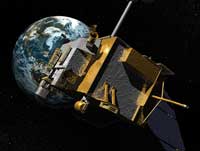|
COMETS EARTH JUPITER KUIPER BELT MARS MERCURY METEORITES NEPTUNE OORT CLOUD PLUTO SATURN SOLAR SYSTEM SPACE SUN URANUS VENUS ORDER PRINTS
PHOTO CATEGORIES SCIENCEVIEWS AMERICAN INDIAN AMPHIBIANS BIRDS BUGS FINE ART FOSSILS THE ISLANDS HISTORICAL PHOTOS MAMMALS OTHER PARKS PLANTS RELIGIOUS REPTILES SCIENCEVIEWS PRINTS
|
Related Documents
Download Options
NASA launched the Lunar Reconnaissance Orbiter, an unmanned mission to comprehensively map the entire moon, on June 18, 2009. One of the instruments aboard, the Diviner Lunar Radiometer Experiment, will make the first global survey of the temperature of the lunar surface while the orbiter circles some 50 kilometers (31 miles) above the moon. The Lunar Reconnaissance Orbiter is the first mission in NASA's Vision for Space Exploration program, a plan to return to the moon and then to travel to Mars and beyond. The mission will gather crucial data on the lunar environment that will help astronauts prepare for long-duration lunar expeditions. JPL designed, built and manages the Diviner instrument for NASA's Exploration Science Mission Directorate, Washington. UCLA is home institution of Diviner's principal investigator, David Paige. NASA's Goddard Spaceflight Center, Greenbelt, Maryland manages the Lunar Reconnaissance Orbiter. It is a NASA mission with international participation from the Institute for Space Research in Moscow. |
